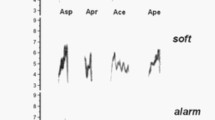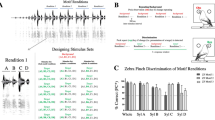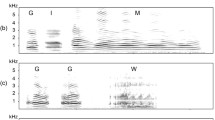Abstract
We examine which acoustic features are relevant for recognition of the cotton-top tamarin (Saguinus oedipus) combination long-call. This vocalization, emitted by both males and females, functions in maintaining group cohesion, territory defense and mate attraction. Using the tamarins’ natural antiphonal vocal response to hearing a combination long-call as the primary measure of recognition, we presented subjects with synthetic exemplars of combination long-calls in which we manipulated across one of three acoustic dimensions: frequency, time and amplitude. Results indicated that although acoustic features in the frequency and time domains are important for combination long-call recognition, the changes in amplitude within and between syllables are not. Furthermore, while the fundamental frequency appears to be the used to encode information about the frequency contour, the temporal information is derived from the harmonics. Overall, these results suggest that tamarins use a specific suite of acoustic features for combination long-call recognition.






Similar content being viewed by others
Abbreviations
- CLC:
-
combination long-call
- F0:
-
fundamental frequency
- JND:
-
just noticeable difference
- JMD:
-
just meaningful difference
- IPI:
-
inter-pulse interval
References
Beeman K (2001) SIGNAL user’s guide. Engineering Design, Belmont, MA
Bieser A (1998) Processing of twitter-call fundamental frequencies in insula and auditory cortex of squirrel monkeys. Exp Brain Res 122:139–148
Brown CH (2003) Ecological and physiological constraints for primate communication. In: Ghazanfar AA (ed) Primate audition: ethology and neurobiology. CRC Press, New York, pp 127–149
Brown CH, Gomez R, Waser PM (1995) Old world monkey vocalizations: adaptations to the local habitat? Anim Behav 50:945–961
Cleveland J, Snowdon CT (1982) The complex vocal repertoire of the adult cotton-top tamarin, Saguinus oedipus oedipus. Z Tierpsychol 58:231–270
Doupe AJ (1997) Song- and order-selective neurons in the songbird anterior forebrain and their emergence during vocal development. J Neurosci 17:1147–1167
Doupe AJ, Solis MM (1999) Song- and order-selective auditory responses emerge in neurons of the songbird anterior forebrain during vocal learning. In: Hauser MD, Konish M (eds) The design of animal communication. MIT Press, Cambridge, MA, pp 343–368
Eliades SJ, Wang X (2003) Sensory-motor interaction in the primate auditory cortex during self-initiated vocalizations. J Neurophysiol 89:2185–2207
Emlen ST (1972) An experimental analysis of the parameters of bird song eliciting species recognition. Behaviour 41:130–171
Gerhardt HC (1991) Female mate choice in treefrogs: static and dynamic acoustic criteria. Anim Behav 42:615–636
Gerhardt HC, Huber F (2002) Acoustic communication in insects and anurans. Chicago University Press, Chicago
Ghazanfar AA, Flombaum JI, Miller CT, Hauser MD (2001) The units of perception in cotton-top tamarin (Saguinus oedipus) long calls. J Comp Physiol A 187:27–35
Ghazanfar AA, Smith-Rohrberg DL, Pollen A, Hauser MD (2002) Temporal cues in the antiphonal calling behavior of cotton-top tamarins. Anim Behav 64:427–438
Grace JA, Amin N, Singh NC, Theunissen FE (2003) Selectivity for conspecific song in the zebra finch auditory forebrain. J Neurophysiol 89:472–487
Green S (1975) Dialects in Japanese monkeys: vocal learning and cultural transmission of locale-specific behavior? Z Tierpsychol 38:304–314
Hauser MD (1996) The evolution of communication. MIT Press, Cambridge
Hauser MD, Fowler C (1992) Declination in fundamental frequency is not unique to human speech: evidence from nonhuman primates. J Acoust Soc Am 91:363–369
Konishi M (1985) Birdsong: from behavior to neuron. Annu Rev Neurosci 8:125–170
Konishi M (1994) An outline of recent advances in birdsong neurobiology. Brain Behav Evol 44:279–285
Marler P (1970) A comparative approach to vocal learning: song development in white-crowned sparrows. J Comp Physiol Psychol 71:1–25
Marler P (1991) Song learning behavior: the interface with neuroethology. TINS 14:199–206
Marler P (1997) Three models of song learning: evidence from behavior. J Neurobiol 33:1-16
Miller CT, Dibble E, Hauser MD (2001) Amodal completion of acoustic signals by a nonhuman primate. Nat Neurosci 4:783–784
Miller CT, Weiss DJ, Hauser MD (2003a) Mechanisms of acoustic perception in cotton-top tamarins. In: Ghazanfar AA (ed) Primate audition: behavior and neurobiology. CRC Press, Boca Raton, pp 43–60
Miller CT, Flusberg S, Hauser MD (2003b) Interruptibility of cotton-top tamarin long calls: implications for vocal control. J Exp Biol 206:2629–2639
Mitani J, Marler P (1989) A phonological analysis of male gibbon singing behavior. Behaviour 109:20–45
Moody DB, Stebbins WC (1989) Salience of frequency modulation in primate communication. In: Dooling RJ, Hulse SH (eds) The comparative psychology of audition. Lawrence Erlbaum, Hillsdale, NJ, pp 353–378
Nelson DA (1988) Feature weighting in species song recognition by the field sparrow (Spizella pusilla). Behaviour 106:158–182
Nelson DA (1997) Social interaction and sensitive phases for song learning: a critical review. In: Snowdon CT, Hausberger M (eds) Social influences on vocal development. Cambridge University Press, Cambridge, UK
Nelson DA, Marler P (1990) The perception of birdsong and an ecological concept of signal space. In: Stebbins WC, Berkley MA (eds) Comparative perception, vol II: complex signals. Wiley, New York, pp 443–478
Newman JD, Wollberg Z (1973a) Multiple coding of species-specific vocalizations in the auditory cortex of squirrel monkeys. Brain Res 54:287–304
Newman JD, Wollberg Z (1973b) Responses of single neurons in the auditory cortex of squirrel monkeys to variants of a single call type. Exp Neurol 40:821–824
Owren MJ (1990) Acoustic classification of alarm calls by vervet monkeys (Cercopithecus aethiops) and humans. II. Synthetic calls. J Comp Psychol 104:29–40
Rauschecker JP, Tian B, Hauser M (1995) Processing of complex sounds in the macaque nonprimary auditory cortex. Science 268:111–114
Ryan MJ (2001) Anuran communication. Smithsonian Institution Press, Washington, D.C.
Ryan MJ, Rand AS (1995) Female responses to ancestral advertisement calls in Tungara frogs. Science 269:390–392
Searcy WA, Brenowitz EA (1988) Sexual differences in species recognition of avian song. Nature 332:152-154
Searcy WA, Podos J, Peters S, Nowicki S (1995) Discrimination of song types and variants in song sparrows. Anim Behav 49:1219–1226
Sen K, Theunissen FE, Doupe AJ (2001) Feature analysis of natural sounds in the songbird auditory cortex. J Neurophysiol 86:1145–1458
Snowdon CT (1993) A vocal taxonomy of the callitrichids. In: Rylands AB (ed) Marmosets and tamarins: systematics, behaviour and ecology. Oxford University Press, New York
Soha JA, Marler P (2000) A species-specific acoustic cue for selective song learning in the white-crowned sparrow. Anim Behav 60:297–306
Solis MM, Doupe AJ (1997) Anterior forebrain neurons develop selectivity by an intermediate stage of birdsong learning. J Neurosci 17:6447–6462
Solis MM, Doupe AJ (2000) Compromised neural selectivity for song in birds with impaired sensorimotor learning. Neuron 25:109–121
Wang X, Kadia SC (2001) Differential representation of species-specific primate vocalizations in the auditory cortices of marmoset and cat. J Neurophysiol 86:2616–2620
Waser PM (1977) Experimental playbacks show vocal mediation of avoidance on a forest monkey. Nature 255:56–58
Waser PM, Brown CH (1986) Habitat acoustics and primate communication. Am J Primatol 10:135–154
Waser PM, Waser MS (1977) Experimental studies of primate vocalization—specialization for long distance propagation. Z Tierpsychol 43:239–263
Weiss DJ, Hauser MD (2002) Perception of harmonics in the combination long call of cotton-top tamarins (Saguinus oedipus). Anim Behav 64:415–426
Weiss DJ, Garibaldi BT, Hauser MD (2001) The production and perception of long calls by cotton-top tamarins (Saguinus oedipus): acoustic analyses and playback experiments. J Comp Psychol 11:258–271
Whaling CS, Solis MM, Doupe AJ, Soha JA, Marler P (1997) Acoustic and neural bases for innate recognition of song. PNAS 94:12694–12698
Wiley RH, Richards DG (1978) Physical constraints on acoustic communication in the atmosphere: implications for the evolution of animal vocalizations. Behav Ecol Sociobiol 3:69–94
Winter P (1969) Dialects in squirrel monkeys: vocalizations of the Roman arch type. Folia Primatol 10:216–229
Winter P, Funkenstein HH (1973) The effect of species-specific vocalizations on the discharge of auditory cortical cells in the awake squirrel monkey. Exp Brain Res 18:489–504
Acknowledgements
We would like to thank Matt Kamen, Teddy Jones, and Grace Wang for their invaluable help running these experiments. Asif Ghazanfar, Roian Egnor and two anonymous reviewers provided helpful comments on an earlier draft that greatly improved the manuscript. We thank the NERPRC for providing some of the initial founding members of the colony. This work was supported by a NIH Individual NRSA Predoctoral Fellowship to C.T.M. and grants from the NSF, NIH and McDonnell Foundation to M.D.H.
Author information
Authors and Affiliations
Corresponding author
Rights and permissions
About this article
Cite this article
Miller, C.T., Hauser, M.D. Multiple acoustic features underlie vocal signal recognition in tamarins: antiphonal calling experiments. J Comp Physiol A 190, 7–19 (2004). https://doi.org/10.1007/s00359-003-0468-1
Received:
Revised:
Accepted:
Published:
Issue Date:
DOI: https://doi.org/10.1007/s00359-003-0468-1




